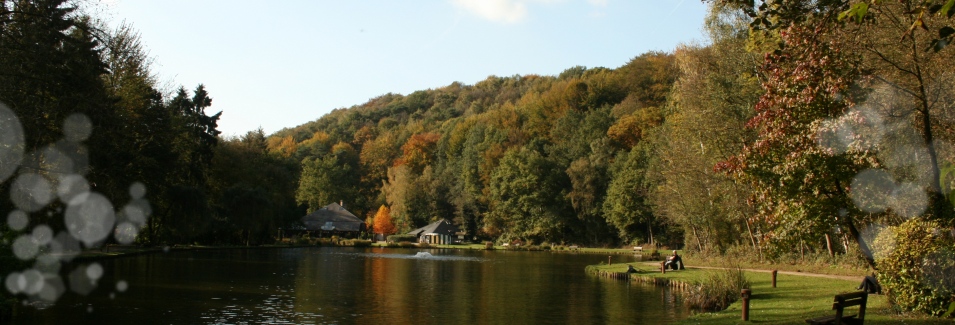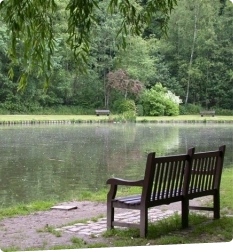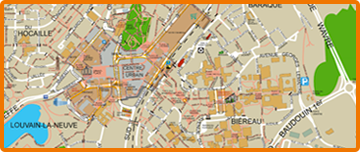

Contact
us

Discovery tour
Newsletter
Get tourist news on Ottignies-Louvain-la-Neuve


Walk to the Bois des Rêves
Promenade No. 5: Woods of Dreams - Bruyères
1. Rue de Morimont
The point of departure of this walk extends through the Woods of Dreams, which is no longer necessary to introduce. The beautiful hedge that borders the woods is planted with various tree species. The extensive flowering of the shadbush, the wild cherry tree and the hawthorn offers a visual delight from April to June. On the left, you can note the presence of four very beautiful oaks that certainly merit being listed.
2. Ry Angon Lagooning
At the entrance of the woods, a small bridge crosses the “Ry Angon” river. On the left, four basins made up the lagooning purification station. Created fifteen years ago by the Province, they were completely silted. A current project aims to restart these developments for educational and purification purposes. A new path was completed. A first basin will serve for decanting. The others, in which specific plantings will be completed- will function in pairs. The kingfisher, now rare in the Walloon Region, was observed in the woods fifteen years ago. The current projects in the lagooning station should promote nesting.
Further, on the left, you can see Brou (from the Walloon “broetia”, which means quagmire). Located in a humid area, this site deserves particular attention.
Climbing up the beech woods, one passes a few imposing properties.
3. From Rue de l'Élevage towards Rue de Mont-St-Guibert
At the summit of the Chemin de Morimont, you must properly follow the map to reach Rue de l'Élevage, towards the pediatric medical center Clairs Vallons. The 100 meters that separate you from the Horse Farm are “the less pedestrian paths” of the trail (look out for cars!). The slopes are colonized by broom: a godsend for rabbits, dun hocks, black headed warblers… From the Clairs Vallons, you can observe the brand-new "Bruyères VIII" district. On your left you will find the "Bruyères VII" district, constructed around the lake.
4. The surrounding area of the Bruyères horse farm
Below the old buildings of the farm, an old orchard was planted by the university. Despite protection, the trees are often victim to nibbling from roe and donkeys.
5. Upstream the lake
A 60-are area was protected from all human intrusion by a fence. To promote wild life as much as possible, three types of developments were made here: new willow and alder plantings, completion of a late mowing and pool creation. The first pool serves as a storm basin for the water from RN 238. The four other basins planted with yellow irises, rush, etc. serve for water purification from the storm basin. Here there are several broom plants. This shrub from the leguminous family, like beans and peas, has black pods that reflect the sun.
6. The lake
The city of Louvain-la-Neuve disposes of a double draining network. While the water used is led to a purification station in Wavre, rain water is sent to the lake. Artificially created at the bottom of the Malaise Valley, the lake acts as a storm basin for water from the rivers of different valleys (Lauzelle, Hocaille, Bruyères). Its gently sloped profile, the presence of a central island and vegetation-covered borders, make it an ideal refuge for numerous bird species. For several years, the crested grebe has lived here.
7. Point du Jour Trail
An incredible oak, which merits listing, guards a small white house from which the old trail breaks through (has suffered severe disrepair in recent years, notably following multiple urbanization projects). The City and UCL want to conserve the charm of this pretty small trail. Recently, new plantings (oaks, blue beeches, hawthorns, elders) were made there.
After approximately 300 meters, you are led to the left towards Rue du Rondia, passing under a building.
8. Rondes Bosses Garden
Leave Rue du Rondia by a second covered walkway. You can then cross the Rondes Bosses ("Round Blumps") Garden to the Fil à Plomb ("Plumb Line") path. This children's paradise is bordered by a specific type of prunus, the PRUNUS SUBHIRTELLA “AUTUMALIS ROSEA” that blooms in autumn and spring.
You then cross the small Palette Woods. This 60-are green space separates the old district of Bruyères - more student oriented – from the new residential district. It connects to the lake, where you can join the “Reverie for the Solitary Walker” trail. Pass the Aula Magna to continue towards the district of Hocaille. You can see the church and houses suspended in the valley.
9. View of the Bruyères district
Passing under the Boulevard André Oleffe by the 2nd exit, you end up facing the small trail that descends to the district of Hocaille. From there, you can take a last glance at the district of Bruyères. Here there is a sculpture made from the root of a camphor found in the China Sea (work of SOFU TESTHIGAHARA).
10. A humid area along Rue de la Malaise
Pass under the RN 238 bridge to go towards Rue de la Malaise. Before entering the woods, there is a sedge meadow on the left. It is partially invaded by comfrey, cow parsley, bindweed…
11. The humid Malaise valley floor
Stay on the main trail that runs the length of the Malaise until the pond of the Woods of Dreams (attention: pedestrians cannot take the neighboring path reserved for horses). Mainly made up of alders accompanied by an ash, hazelnut tree and rowan tree, this humid valley floor, kept very natural, offers a fresh respite. Deer can be seen regularly in the environment, particularly in the winter, given the proximity of running water that does not freeze.
The botanical garden
In the Palette Woods, you can visit the botanical garden. Located behind the Biéreau farm, of which the restoration project ended in 2005, this space served as a nursery during the creation of Louvain-la-Neuve. Abandoned for a long time, it was the object of a true face lift to convert it into an outdoor concert hall. Particular tree species were planted there, like a Lebanese cedar, offered to UCL by the ambassador of Lebanon, and a METASEQUOIA.
Sit down on the arc-arranged stones that decorate the lawn to observe the imposing poplar that was probably planted on the border of the pool in the middle of the 18th century. The farm and the 110 hectares of land and woods belonged to the abbey of Florival until 1798.







